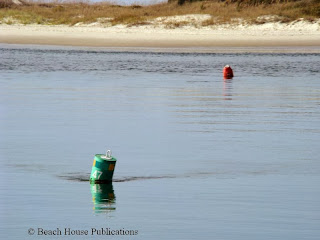From Southport, the Atlantic Intracoastal Waterway runs along the Atlantic coast with no more than barrier islands separating the waterway from the Atlantic Ocean. There are many resort towns along this stretch and also a few inlets that need to be transited. Two of those inlets, Lockwoods Folly and Shallotte Inlet are famous for shoaling and being difficult passages. Once off the dock at around 8:30 a.m., we would transit both of these in one day before reaching our next destination at Myrtle Beach. It's always better to transit Lockwoods and Shallotte at mid-tide or higher. The temperatures were cool, but it was a bright sunny day with good conditions forecast.
As we approached Lockwoods Folly, a sailboat had strayed out of the channel and was hard aground. It looked like he may have been trying to pass a channel marker on the wrong side. As we approached, he hailed us on the VHF to announce his predicament. Our response was to ask if we might put up a wake as we passed in hopes that it would allow him to bounce off the shoal. This has worked for us on a few occasions. We passed by at full throttle, but our wake is not that large and had little effect. We turned around and tried once again with no effect so we called and wished him well. The tides would come up and he would be off in a few hours. To our surprise, as we headed into the inlet crossing we saw him work himself free. The shallowest depths encountered at the intersection of the inlet and ICW was 7.5 feet mid-channel between floating markers 47A and 48. These floating markers are often relocated to show the deepest waters. During times of severe shoaling, the channel here can get as low as 3 feet and boats can only make it through at higher tides. Today would not be an issue.
Almost exactly an hour later, Beach House was crossing Shallotte Inlet. This inlet was a little more involved to get through and stay in the deeper water. From green markers "71" to "75" it's best to stay on the green side of the channel. As we approached floating red "76," we ran almost right up to the marker and found 13.5 feet of water. In the channel between markers red "80A" and green "81," the depths were only 5.3 feet. The trick here is to go directly from "80A" and aim for "81." Once past "81," we moved back toward the center of the channel. From there, the depths held just fine. Once these two inlets were behind us, it was truly smooth sailing the rest of the way. The next inlet south is Little River, and that one is deep and wide with no hazards other than some cross currents where the inlet crosses the waterway. Large gambling ships come in and out all the times. Once past Little River, you are now in South Carolina. We were still looking for warmer temperatures.
The rest of the waterway is a narrow canal lined with golf courses, large homes and giant shopping centers and all of the attractions Myrtle Beach has to offer. Just before 2:00 p.m., Beach House was tied up in a slip at the Myrtle Beach Yacht Club. This is another of our favorite marina stops along the ICW. The marina is in a protected basin just off the ICW with floating docks, fuel, a restaurant, pump out and some of the friendliest folks you will meet. They are also a seller of our anchorage books so we wanted to show them the new Bahamas book. Our slip assignment was near the office, showers and restrooms and next to the pool. It was also good timing since the marina had a Customer Appreciation Day, complete with good food, drinks and prizes. They put out quite a spread and many of the cruisers passing through, as well as regular year-round slip holders, attended. These get-togethers are great and offer the chance to meet up again with old acquaintances and make new friends. Deteriorating weather kept us at the marina for a few days. Not like we really minded. And there was that emergency run to the dentist to re-cement a crown...
Subscribe to:
Post Comments (Atom)












I was wondering if you have tried or had any experience with any type of sonar or other instrument to judge depth forward of the boat. Still getting information and learning. Thank you
ReplyDeleteJames, I've installed the forward looking sonar on several boats and have never been impressed with it. Most owners found it difficult to use and interpret after the install. The display takes some interpreting that is not like our usual depth sounders and many find it confusing. You don't get a lot of range and on faster boats it might not help much. Their performance has been reported as inconsistent and in any kind of seas, of little value. In truth, it as been a while since I have worked with these units and there may have been improvements. But I'm not hearing anything from other boaters that lead me to believe things have improved significantly. Chuck
Delete